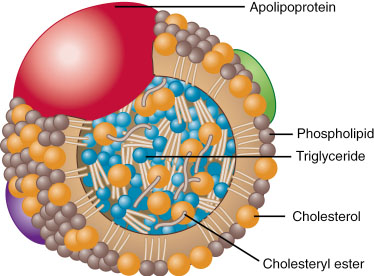* * *
Any complex or compound containing both lipid and protein. Lipoproteins are important constituents of biological membranes and of myelin. Conjugation with protein facilitates transport of lipids, which are hydrophobic, in the aqueous medium of the plasma. Plasma lipoproteins can be separated by ultracentrifugation, electrophoresis, or immunoelectrophoresis; they migrate electrophoretically with α- and β-globulins, but are usually classified according to their densities (flotation constants). The principal classes by density are chylomicrons, which transport dietary cholesterol and triglycerides from the intestine to the liver and other tissues; very low density lipoproteins (VLDL), which transport triglycerides from intestine and liver to muscle and adipose tissue; low density lipoproteins (LDL), which transport cholesterol to tissues other than the liver; and high density lipoproteins (HDL), which transport cholesterol to the liver for excretion in bile. The properties of these and other plasma lipoproteins are set forth in the accompanying table. The protein moiety of a l. is called an apolipoprotein (or apoprotein). Besides rendering lipids soluble, some apolipoproteins perform biochemical functions such as enzyme activation. The apolipoproteins of plasma lipoproteins are synthesized by the liver and intestinal mucosal cells and vary in molecular weight from 7000 to 500,000. Protein makes up more than 50% of some HDLs but only 1% of chylomicrons. As the proportion of lipid in a l. increases, its density decreases. A plasma l. particle is typically spherical, with a hydrophobic core of triacylglycerol, cholesteryl esters, and apolar amino acid residues surrounded by hydrophilic protein structures and phospholipids.The concentrations of certain serum lipoproteins correlate closely with the risk of atherosclerosis. An HDL cholesterol level below 35 mg/dL (0.90 mmol/L), an LDL cholesterol level above 160 mg/dL (4.15 mmol/L), and a fasting triglyceride level above 250 mg/dL are all independent risk factors for coronary artery disease. Although dietary factors are important in some persons, basal levels of l., cholesterol, and triglycerides depend chiefly on heredity. Several phenotypes of familial hyperlipoproteinemia associated with risk of premature cardiovascular disease and death have been identified. see hyperlipoproteinemia. Medical management of patients with coronary artery disease (myocardial infarction, angina pectoris, history of coronary artery bypass graft or coronary angioplasty) and other atherosclerotic disorders (peripheral arterial disease, abdominal aortic aneurysm, carotid artery disease) includes detection and correction of hypercholesterolemia and hyperlipoproteinemia. Reducing elevated LDL cholesterol diminishes the risk of coronary artery disease; besides halting the progression of atherosclerosis, it may even shrink established atherosclerotic lesions. Of persons with elevated LDL cholesterol, 75% can achieve normal levels with diet, weight reduction, and exercise; the remainder need drug treatment. Factors besides familial hyperlipoproteinemias that can elevate LDL cholesterol include diabetes mellitus, hypothyroidism, nephrotic syndrome, obstructive liver disease, and drugs (progestogens, anabolic steroids, corticosteroids, thiazide diuretics). Dietary saturated fat raises LDL cholesterol more than any other dietary component, cholesterol itself not excepted.
- l. (a) a l. consisting of an LDL particle to which a large glycoprotein, apolipoprotein (a), is covalently bonded. Elevation of the concentration in serum has been identified as a risk factor for coronary artery disease.Elevation of plasma l. (a) above 30 mg/dL is a strong independent risk factor for coronary artery disease and possibly for stroke. A unique feature of l. (a) is the structural similarity of its nonlipid moiety, apolipoprotein (a), to plasminogen. This similarity allows it to bind to endothelium and to proteins of cellular membranes. It inhibits fibrinolysis by competing for plasminogen binding sites and also favors lipid deposition and stimulates smooth muscle cell proliferation. Niacin and estrogen lower Lp(a), but HMG-CoA reductase inhibitors, fibrates, and bile acid sequestrants do not.
- α1-l. A l. fraction of relatively low molecular weight, high density, rich in phospholipids, and found in the α1-globulin fraction of human plasma.
- β1-l. A l. fraction of relatively high molecular weight, low density, rich in cholesterol, and found in the β-globulin fraction of human plasma.
- intermediate density l. (IDL) class of lipoproteins formed in degradation of very low density lipoproteins; about half are cleared quickly from the plasma into the liver by receptor-mediated endocytosis; the other half are degraded into low density lipoproteins.
- l. Lp(a) a l. composed of an LDL particle combined with an additional protein, Lp(a) specific protein; elevated levels have been identified as a risk factor for coronary artery disease; elevations may be treated with niacin.
- malondialdehyde-modified low-density l. lDL molecule with aldehyde-substituted lysine residue(s) in the apoprotein moiety, resulting from oxidative reaction accompanying prostaglandin synthesis and platelet aggregation.
* * *
li·po·pro·tein -'prō-.tēn, -'prōt-ē-ən n any of a large class of conjugated proteins composed of a complex of protein and lipid see HDL, LDL, VLDL
* * *
n.
one of a group of compounds, found in blood plasma and lymph, each consisting of a protein (see apolipoprotein) combined with a lipid (which may be cholesterol, a triglyceride, or a phospholipid). Lipoproteins are important for the transport of lipids in the blood and lymph. Cholesterol is transported in the bloodstream in the form of the low-density lipoproteins (LDLs); it is removed from the bloodstream by means of special LDL receptors, which are inserted into the membranes of cells and bind the LDLs, which are then taken into the cells. Other forms of lipoprotein are high-density lipoprotein (HDL), which transports cholesterol from the tissues to the liver, and very low-density lipoprotein (VLDL), which is the precursor of LDL.
* * *
lipo·pro·tein (lip″o-) (li″po-proґtēn) any of the lipid-protein complexes in which lipids are transported in the blood; lipoprotein particles consist of a spherical hydrophobic core of triglycerides or cholesteryl esters surrounded by an amphipathic monolayer of phospholipids, cholesterol, and apolipoproteins; the four principal classes are high-density, low-density, and very-low-density lipoproteins and chylomicrons.

 Diagram of lipoprotein structure showing the envelope of phospholipids and free cholesterol, core of cholesteryl esters and triglycerides, and apolipoprotein protein component.
Diagram of lipoprotein structure showing the envelope of phospholipids and free cholesterol, core of cholesteryl esters and triglycerides, and apolipoprotein protein component.
Medical dictionary. 2011.